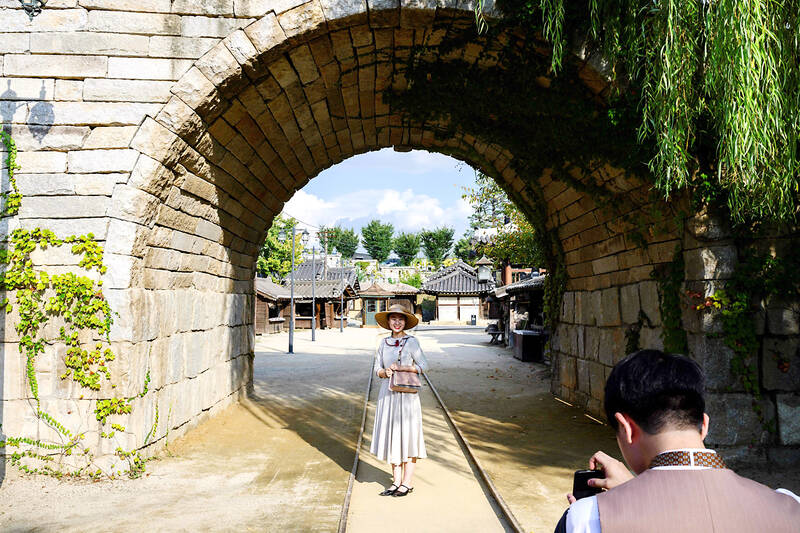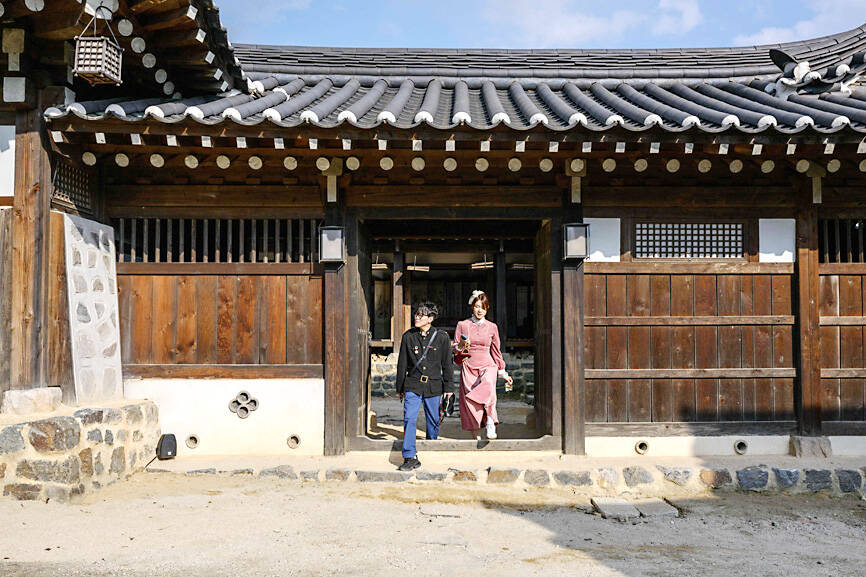Deep in South Korea’s hinterlands lies a perfect replica of 1900s Seoul: Welcome to Sunshine Land, the latest K-drama theme park to cash in on booming K-culture tourism.
Fans of K-pop mega group BTS have long flocked to the country to see sites associated with the boy band, from the dorms where they slept as trainees to music video shoot locations.
However, as the popularity of South Korean drama has soared overseas — it is the most-viewed non-English content on Netflix, the platform’s data showed — more tourists are planning trips around their favorite shows.

Photo: AFP
The idea that foreign tourists would pay good money and drive hundreds of kilometers out of the capital, Seoul, to see a K-drama set seemed “crazy” to tour guide Sophy Yoon — until she saw one of her guests break down in tears at Sunshine Land.
“At that moment, it hit me: For me, it was just a studio, but for them, it was something much more,” she said.
Preserved from the set of popular 2018 historical series Mr Sunshine, the location in Nonsan, 170km from Seoul, is replete with painstaking replicas of everything from a turn-of-the-century streetcar to South Korea’s most famous Buddhist bell.

Photo: AFP
“It’s like when we go to the Spanish steps in Rome where Audrey Hepburn had ice cream,” Yoon said, referring to the 1953 classic movie Roman Holiday.
For South Korea’s growing number of K-drama tourists, “every door, every wall has a meaning from a drama that impacted their lives.”
“I get a lot more requests for specific ‘K-drama tours’ now,” she said.
The rise of South Korea as a global cultural powerhouse “has contributed to the appeal of Korean tourism,” said Kwak Jae-yeon, the Hallyu (“Korean Wave”) content team director at the Korea Tourism Organization (KTO).
South Korea welcomed 1.4 million tourists in September, up 33 percent year-on-year and the highest since the COVID-19 pandemic, with more than a third saying they had decided to come “after being exposed to Korean Wave content,” a KTO poll from last year showed.
In Seoul’s central Jongno District, tourists such as Sookariyapa Kakij are typical. Wearing a hanbok, a traditional Korean dress, the 40-year-old had traveled from Thailand specifically to see where her favorite dramas were filmed.
“I want to find locations where Itaewon Class was shot,” she said, referring to the popular 2020 drama, filmed largely on location in its namesake district of Seoul.
Jennifer Zelinski said she had never left the US before, but after she discovered K-drama — through the 2019 series Crash Landing on You — while stuck at home during the pandemic, she decided to visit South Korea.
“I binged the whole show in a week. I barely slept and went through two whole boxes of tissues,” she said.
That “snowballed” into her watching more K-drama, South Korean variety shows and listening to K-pop, until finally she “felt like I really wanted to see it in person,” she said.
“My family and friends were shocked when I said I was traveling to Korea and on my own,” but for her “it just felt right,” Zelinski said.
The travel industry is racing to catch up: one South Korean tour company on the travel platform Klook said interest in its BTS day tour has recently “skyrocketed,” and it was “completely booked until next February.”
“We are planning to add additional tours for other K-pop idol groups, including Seventeen and NCT 127,” it said.
Most of this new type of tourism is concentrated in Seoul, Kyungpook National University professor Jeong Ji-youn said.
Tourism in rural areas has tended to focus on more traditional South Korean experiences, which is not interesting to younger travelers eager to explore the land of K-pop and K-drama.
“There is a need to develop more tourism resources related to contemporary culture that allow people to experience Hallyu outside of Seoul,” she said.
The port city of Pohang is better known for shipbuilding and steel plants than tourism, but Emma Brown, 30, from Scotland, traveled more than 8,800km to see it because of When the Camellia Blooms.
The 2019 romance series “changed my life”, she said, adding that she felt she “had to feel the drama in person.”
“I just couldn’t miss the opportunity to visit Pohang when I was already in South Korea,” she said.

Semiconductor business between Taiwan and the US is a “win-win” model for both sides given the high level of complementarity, the government said yesterday responding to tariff threats from US President Donald Trump. Home to the world’s largest contract chipmaker, Taiwan Semiconductor Manufacturing Co (TSMC, 台積電), Taiwan is a key link in the global technology supply chain for companies such as Apple Inc and Nvidia Corp. Trump said on Monday he plans to impose tariffs on imported chips, pharmaceuticals and steel in an effort to get the producers to make them in the US. “Taiwan and the US semiconductor and other technology industries

SMALL AND EFFICIENT: The Chinese AI app’s initial success has spurred worries in the US that its tech giants’ massive AI spending needs re-evaluation, a market strategist said Chinese artificial intelligence (AI) start-up DeepSeek’s (深度求索) eponymous AI assistant rocketed to the top of Apple Inc’s iPhone download charts, stirring doubts in Silicon Valley about the strength of the US’ technological dominance. The app’s underlying AI model is widely seen as competitive with OpenAI and Meta Platforms Inc’s latest. Its claim that it cost much less to train and develop triggered share moves across Asia’s supply chain. Chinese tech firms linked to DeepSeek, such as Iflytek Co (科大訊飛), surged yesterday, while chipmaking tool makers like Advantest Corp slumped on the potential threat to demand for Nvidia Corp’s AI accelerators. US stock

The US Federal Reserve is expected to announce a pause in rate cuts on Wednesday, as policymakers look to continue tackling inflation under close and vocal scrutiny from US President Donald Trump. The Fed cut its key lending rate by a full percentage point in the final four months of last year and indicated it would move more cautiously going forward amid an uptick in inflation away from its long-term target of 2 percent. “I think they will do nothing, and I think they should do nothing,” Federal Reserve Bank of St Louis former president Jim Bullard said. “I think the

SUBSIDIES: The nominee for commerce secretary indicated the Trump administration wants to put its stamp on the plan, but not unravel it entirely US President Donald Trump’s pick to lead the agency in charge of a US$52 billion semiconductor subsidy program declined to give it unqualified support, raising questions about the disbursement of funds to companies like Intel Corp and Taiwan Semiconductor Manufacturing Co (台積電). “I can’t say that I can honor something I haven’t read,” Howard Lutnick, Trump’s nominee for commerce secretary, said of the binding CHIPS and Science Act awards in a confirmation hearing on Wednesday. “To the extent monies have been disbursed, I would commit to rigorously enforcing documents that have been signed by those companies to make sure we get